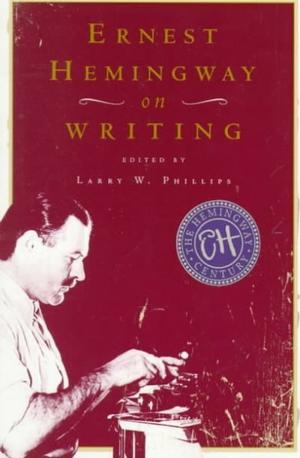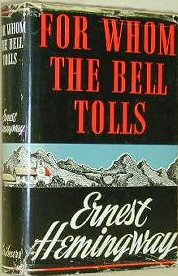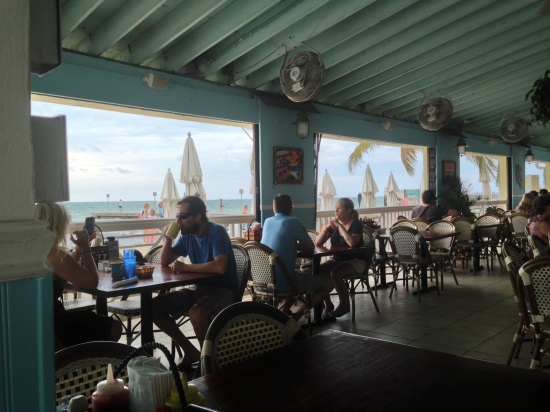Attractions in 2013
These are the Books Can Save a Life posts that got the most views in 2013.
- 1 Reading Junot Diaz
- 2 Children of mental illness, part 1
- 3 Encountering the dark matter of mental illness
- 4 Do genes shape our mental health?
- 5 Hemingway and The Paris Wife
I was gratified to see three of my most popular posts are about having a family member who suffers from mental illness. Early in the new year I’ll be writing about Susan Nathiel’s new book, Sons of Madness: Growing Up and Older with a Mentally Ill Parent. There is still very little written about the experience of having a mother or father with a mental illness; Susan’s book is an important contribution.
Tag: The Paris Wife
Hemingway on life and death, love and war
I believe that basically you write for two people: yourself to try to make it absolutely perfect; or if not that then wonderful. Then you write for who you love whether she can read or write or not and whether she is alive or dead. – Ernest Hemingway on Writing.
 When I visit a new place, I like to read the literature associated with that place or the literature created there. So when I went to Key West last month and the home of Ernest Hemingway, I reread The Sun Also Rises, which Hemingway wrote there, followed by A Farewell to Arms. Last night I finished For Whom the Bell Tolls for the first time and went to bed feeling rather devastated.
When I visit a new place, I like to read the literature associated with that place or the literature created there. So when I went to Key West last month and the home of Ernest Hemingway, I reread The Sun Also Rises, which Hemingway wrote there, followed by A Farewell to Arms. Last night I finished For Whom the Bell Tolls for the first time and went to bed feeling rather devastated.
In my last post I was dismissive of The Sun Also Rises. When I read it the first time, in high school, I didn’t understand the novel. Decades later, I again found the characters tedious, which was Hemingway’s intention, but I at least better understood the context of those alienated, war-devastated years. His writing style, a breakthrough in Hemingway’s time, was for me so stilted and self-conscious it sometimes pulled me completely out of the story, and I especially disliked his sole female character, Lady Brett Ashley.
My post about Hemingway generated a handful of interesting and insightful comments, all by women and mostly about Hemingway’s ego and sexism and macho persona. I wish my blog attracted more male readers, but I have noticed some gender segregation in the book blog world, and I can understand that. I tend to gravitate toward female authors, and when I find I’m reading only books written by women, I’ll switch to a male author. Reading Junot Diaz, for example, was a stretch for me, but I’m glad I did. I had to talk myself into reading Hemingway again, too, but I’m glad I did that as well.
I felt uncomfortable after I was dismissive of The Sun Also Rises, and I thought about that as I read Hemingway’s other novels. Because when all is said and done, I believe Hemingway is a master and, despite my personal reactions to it, I believe The Sun Also Rises is a great book. Visiting Hemingway’s home in Key West and looking at the many candid photos on every wall in every room, I sensed something of his spirit lingering. Reading The Paris Wife and Ernest Hemingway on Writing, I saw not just Hemingway the god-like, iconic writer but Hemingway the vulnerable artist.
I don’t do the close reading of a literary scholar or a book critic, though I admire those that do. On this blog, I don’t write book reviews, and I’ve been frustrated occasionally when I hear people say I do, although I understand why they wouldn’t make these distinctions. If you were to ask me to write a book synopsis or a book review, I’d have no enthusiasm for it. (And I’m a librarian.) Here, I want to share and talk about our own, highly individual reading journeys and our personal reactions to the books we read. I think if you’re an avid reader, books help to make you the person you are, and that’s going to make a difference in what you do and who you are out in the world.
(If you’re not an avid reader, maybe you love nature and have trekked across your country, or you know almost everything there is to know about the earliest jazz recordings, or you can recite from memory every baseball statistic ever recorded, or you’re devoted to helping the poor in Third World countries. You may be on some kind of personal journey of discovery that says something important about who you are and your place in the world. That journey of discovery is what I’m interested in.)
 Here are some of my personal reactions to Hemingway’s novels:
Here are some of my personal reactions to Hemingway’s novels:
- I disliked Lady Brett Ashley because she was self-centered and slept with every man who came her way (except for Jake Barnes). Then I realized the men in The Sun Also Rises were the same, yet I wasn’t as critical of them. I held the female to a different standard.
- When I was young I accepted and enjoyed Hemingway’s fictional romances without question. I didn’t find them sexist or offensive until literary opinion told me I should, even though I came of age just after the feminist heyday. Now, while I don’t especially enjoy Hemingway’s portrayal of women, I have to say many women acted that way. I think Hemingway understood how we idealize the other in romantic love, and how we look to each other for rescue or at least a safe haven.
- I have trouble understanding the American Robert Jordan’s idealism and motivation for volunteering to fight in the Spanish Civil War in For Whom the Bell Tolls. But when I think about the Americans in Iraq and Afghanistan, I’m bothered that many of us are so emotionally removed from the reality of these wars and the sacrifices a small number of Americans are making. Since I’m not especially attracted to war novels, at first I didn’t take to For Whom the Bell Tolls. I didn’t want to follow Robert Jordan and the others on their mission to blow up the bridge. Of course, I became emotionally entangled in Robert’s relationship with Maria and the others. Hemingway fought and was nearly killed in World War I and reported from the front lines during the Spanish Civil War and World War II, so he understood war and he knew how to write about it. The last one hundred pages of For Whom the Bell Tolls contain some of the most beautiful, poignant and universally truthful passages I’ve ever read. With the final sentence, I do believe Hemingway achieved perfection.
BY ERNEST HEMINGWAY
A Moveable Feast
For Whom the Bell Tolls
The Old Man and the Sea
A Farewell to Arms
The Sun Also Rises
A Clean Well-Lighted Place
In Our Time
The Garden of Eden
To Have and Have Not
Men Without Women
Islands in the Stream
Death in the Afternoon

Hemingway and The Paris Wife
I wished I had died before I ever loved anyone but her. Ernest Hemingway, A Moveable Feast
 I was prepared not to like The Paris Wife, Paula McLain’s novel about Ernest Hemingway’s first of four marriages, to Hadley Richardson, written from Hadley’s point of view. Generally, I don’t like novelized versions of real people’s lives. The author has to work doubly hard for me to wholeheartedly enter her fictional world, because I can’t forget we’re seeing actual events filtered through her idiosyncratic speculations, which could be way off base.
I was prepared not to like The Paris Wife, Paula McLain’s novel about Ernest Hemingway’s first of four marriages, to Hadley Richardson, written from Hadley’s point of view. Generally, I don’t like novelized versions of real people’s lives. The author has to work doubly hard for me to wholeheartedly enter her fictional world, because I can’t forget we’re seeing actual events filtered through her idiosyncratic speculations, which could be way off base.
I read The Paris Wife back-to-back with Hemingway’s The Sun Also Rises (which I read years ago) because I thought it would be interesting to see portrayed, in The Paris Wife, the “real” people who were models for Hemingway’s characters in The Sun Also Rises. (I hope you can follow this.) These two books I read while spending a few days in Key West with my family and visiting Hemingway’s former home, now a museum.
I found The Sun Also Rises just as tedious as when I read it as a baffled teenager. Aimless, self-absorbed people endlessly drinking in European bars and cafes, and then they go to a bullfight. I half-wished Hemingway would kill off the insufferable former war-time nurse, Lady Brett Ashley, but I knew better. I had to laugh when a note left by a previous reader fluttered out from between the pages of my library book: “Brett is a low-class whore.”
But this time, I tried to understand who these people were: the post World War I Lost Generation, stunned and alienated after the bloodiest war in history, surrounded by stratospheric, dissipated wealth alongside abject poverty. Despite my initial reservations, The Paris Wife was a good read and helped me see Hemingway and his first novel in a new light. Hemingway (and Jake Barnes, Hemingway’s alter ego in The Sun Also Rises) almost certainly had what we’d call today post-traumatic stress disorder. I hadn’t realized Hemingway was only 18 (about my son’s age) when he served as an ambulance driver in the war, saw horrific battles, and was seriously wounded. He then fell in love with a nurse a few years older than he (Catherine was her incarnation in A Farewell to Arms) who called off their marriage after she fell in love with an Italian officer.
This was Hemingway’s state of mind at 21 when he met Hadley, who was 28. I don’t mean to suggest his early adult experiences explain everything about Hemingway, because personalities and destinies are more complex than that. But Paula McLain is an excellent storyteller, and I trust her when she portrays a couple who were so right for each other at the time in their lives when they met, and then so wrong for each other a few years later, when both needed to move on.
(By the way, Paula lives in Cleveland, my hometown, and she wrote much of this book in a Starbucks there. Paula has also written a memoir about growing up in foster homes, Like Family: Growing Up in Other People’s Houses, which I look forward to reading.)
Here are some of my thoughts and impressions:
- The Paris Wife didn’t fare well with many critics, but it is a bestseller. I think the more of a literary scholar and purist you are, the pickier you’ll be about how accurately McLain portrays motivations and personalities, how authentically and gracefully she finesses the dialog, and other matters. What I loved about her book was how richly she recreated the unconventional life led by an artistic, adventure-loving couple living in strange, unsettling times.
- I appreciate the dynamic of the Hemingway-Hadley relationship McLain depicts. How the strong, self-effacing (and some would say stodgy and boring) Hadley appreciated, nurtured, and was subservient to the great artistic personality. But it wasn’t all one way. As Hadley wrote much later, Hemingway entered her life like an explosion and liberated her from what could have been a circumscribed, unrealized life. For a time, there was deep, genuine love between the two, and even though the marriage broke up, the trajectory of Hadley’s life was forever altered.
- Marriages that end the way the first Hemingway marriage did are never pretty, but I think the ending of this marriage was especially nasty and torturous for Hadley. Pauline Pfeiffer, Vogue writer and wife #2, literally made my skin crawl. At the end of his life, Hemingway wrote an apology to Hadley, which he included in A Moveable Feast, a memoir in which he lovingly recalls his early years with Hadley. There has been more than one edition of A Moveable Feast, and I find it amusing that the edition published by one of the descendents of the Hemingway-Pfeiffer children removed the apology.
 Ernest Hemingway’s Key West home
Ernest Hemingway’s Key West homeAfter Hemingway married Pauline, they moved to Key West. Visiting their former Spanish colonial home, I loved the wraparound balcony on the second floor and the tall, shuttered windows that let in the sea breezes, but there was an air of sadness and neglect about the place.
After his marriage to Pauline ended, Hemingway moved to Cuba, where he married journalist Martha Gellhorn. That marriage ended, too, and he spent his last years married to Mary Welsh in Idaho.
When my husband and son went snorkeling off the coast of Key West, their guide pointed out four posts several miles out. At one time, Hemingway’s “stilt” house, or fishing shack, sat atop these posts, where he’d spend days in solitude, writing. The writing life, Hemingway once wrote, is a lonely life.
 Key West sunset
Key West sunsetIf you’ve read The Paris Wife and want to comment, or if you have thoughts about Ernest Hemingway, please add them to the comments below.


